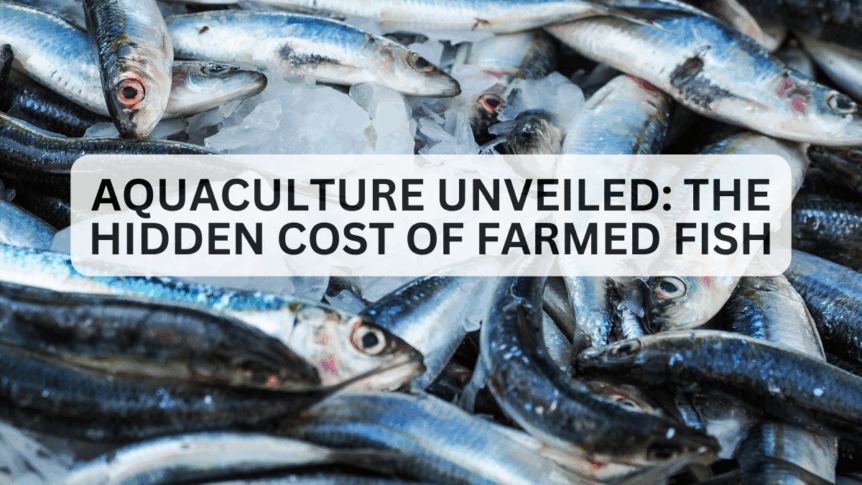When we think of factory farming, images of crowded chicken sheds and industrial dairy operations typically come to mind. But there’s another rapidly growing form of animal agriculture that often swims beneath the radar of public scrutiny: aquaculture.
At Animal Outlook, our investigations have consistently revealed the dark realities behind closed doors of animal agriculture. Today, we’re diving deep into the murky waters of fish farming, an industry that markets itself as the sustainable solution to overfishing while concealing troubling truths about animal welfare, environmental degradation, and public health risks.
The Underwater Factory Farm
Imagine spending your entire life in a space so crowded you can barely turn around, swimming in water contaminated with your own waste, suffering from parasites, and diseases that ravage your body. This is the reality for billions of farmed fish.
Modern aquaculture operations pack fish into underwater cages or tanks at densities that would be unimaginable in natural settings. Atlantic salmon, for example, are typically confined at densities up to 25 kg of fish per cubic meter of water, equivalent to 27 adult salmon squeezed into a standard bathtub.
These extreme stocking densities create perfect conditions for disease outbreaks and parasite infestations. Sea lice, parasites that feed on fish skin, blood, and mucus, have become endemic in salmon farms, causing painful lesions and suffering.1 The industry’s solution? Harsh chemical treatments that cause additional stress and suffering to the already compromised fish.
Sentient Beings, Not Swimming Vegetables
Science has definitively established that fish are sentient beings capable of feeling pain, experiencing fear, and forming complex social bonds. Yet the aquaculture industry treats them as little more than swimming crops to be harvested.
The slaughter methods used in aquaculture would shock most consumers. Many farmed fish are killed through asphyxiation, being left to suffocate in air, a process that can take up to 15 minutes of conscious suffering. Others are plunged into ice slurries where they slowly freeze to death, or have their gills cut without stunning, leading to a slow, painful death.
These practices would never be accepted for land animals, yet they remain standard in an industry that operates largely out of sight.
Environmental Devastation in the Name of Sustainability
Perhaps the greatest deception of the aquaculture industry is its claim of environmental sustainability. The reality couldn’t be further from the truth.
Coastal fish farms release enormous amounts of untreated waste directly into surrounding waters. Feces, uneaten feed, antibiotics, and pesticides flow freely into marine ecosystems. A single medium-sized salmon farm produces waste equivalent to a city of 10,000 people, but without any sewage treatment.
Then there’s the feed issue. Farming carnivorous fish like salmon requires catching wild fish to produce fish meal and fish oil; it takes up to 2.4 pounds of wild fish to produce 1 pound of farmed salmon.2 This practice is depleting populations of small fish that are crucial to marine food webs, affecting everything from larger fish to seabirds and marine mammals.
The industry’s expansion into sensitive coastal areas has destroyed critical mangrove forests, seagrass beds, and other habitats that serve as nurseries for marine life and protect coastlines from storms and erosion.
The Human Health Myth
Consumers are told that farmed fish is a healthy choice, but aquaculture’s dirty secrets extend to human health concerns as well. Farmed fish often contain higher levels of pollutants like PCBs and dioxins than their wild counterparts, along with residues from the antibiotics and pesticides used to control disease in crowded conditions.
The overuse of antibiotics in aquaculture is contributing to the global crisis of antibiotic resistance, creating superbugs that threaten both human and animal health. Yet this practice continues largely unregulated in many of the countries where aquaculture is expanding most rapidly.
Better Way Forward
At Animal Outlook, we believe in exposing these hidden realities and inspiring change. The good news is that consumers have the power to drive transformation through their choices.
Plant-based seafood alternatives are rapidly evolving, with innovative products mimicking the taste, texture, and nutritional profile of fish without the welfare concerns or environmental destruction. From crispy “fish” fillets made from banana blossoms to tuna alternatives crafted from tomatoes and algae oil—compassionate options abound.
By shifting toward plant-based alternatives, we can protect marine ecosystems, prevent fish suffering, and safeguard human health, all while enjoying delicious, nutritious food.
Join Us in Creating Change
Our work exposing the truth behind animal agriculture depends on supporters like you. Your donations fund crucial investigations, legal advocacy, and consumer education that create meaningful change for animals.
Together, we can bring the hidden realities of aquaculture into the light and inspire a more compassionate, sustainable food system.
1https://www.nhm.ac.uk/discover/the-problem-of-sea-lice-in-salmon-farms.html
2https://www.seaaroundus.org/newspapers/2002/LATimes_9Dec02.pdf

